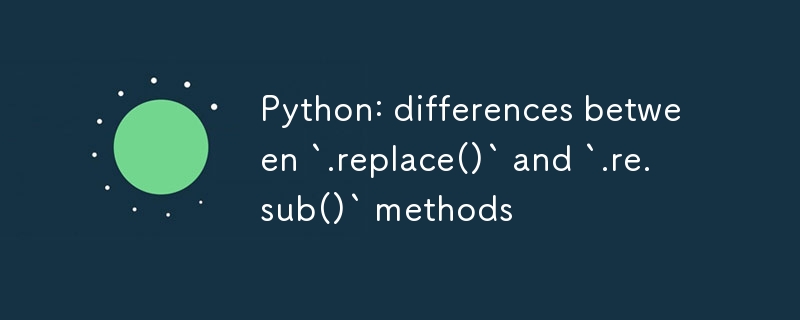Python:“.replace()”和“.re.sub()”方法之间的差异
发布于2024-08-25

介绍
Python中的.replace()方法和.re.sub()函数都用于替换部分字符串,但它们具有不同的功能和用例。以下是它们之间的根本区别:
-
模块和使用上下文:
-
。代替():
- 属于str类。
- 用作字符串对象的方法。
- 语法:str.replace(old, new, count=-1)
- 示例: 'hello world'.replace('world', 'Python') 结果为 'hello Python'。
-
。代替():
-
.re.sub():
- 属于re模块(正则表达式)。
- 用作 re 模块的函数。
- 语法:re.sub(pattern, repl, string, count=0, flags=0)
- 示例:re.sub(r'\bworld\b', 'Python', 'hello world') 结果为 'hello Python'。
-
模式匹配:
-
。代替():
- 仅支持简单的字符串匹配。
- 不能使用正则表达式或复杂模式。
- 如果未指定计数,则替换所有出现的子字符串。
-
。代替():
-
.re.sub():
- 支持正则表达式,允许复杂的模式匹配。
- 可以根据字符类、重复和分组等模式进行匹配和替换。
- 允许使用反向引用并可以处理更复杂的替换。
-
更换灵活性:
-
。代替():
- 仅限于用另一个固定子字符串替换固定子字符串。
- 没有高级替换功能,例如捕获组或条件替换。
-
。代替():
-
.re.sub():
- 允许使用捕获组进行动态替换。
- 替换字符串 (repl) 可以引用模式中的匹配组。
- 可以使用函数作为替换,这允许基于匹配进行复杂且动态的替换。
-
表现:
-
。代替():
- 简单替换通常更快,因为它不涉及模式匹配。
-
。代替():
-
.re.sub():
- 由于正则表达式处理的开销,通常比 .replace() 慢。
示例
使用 .replace():
text = "The quick brown fox jumps over the lazy dog"
result = text.replace("fox", "cat")
print(result) # Output: The quick brown cat jumps over the lazy dog
使用.re.sub():
import re text = "The quick brown fox jumps over the lazy dog" pattern = r'\bfox\b' replacement = "cat" result = re.sub(pattern, replacement, text) print(result) # Output: The quick brown cat jumps over the lazy dog
.re.sub() 的高级示例:
import re text = "The quick brown fox jumps over the lazy dog" pattern = r'(\b\w \b)' # Matches each word replacement = lambda match: match.group(1)[::-1] # Reverses each matched word result = re.sub(pattern, replacement, text) print(result) # Output: ehT kciuq nworb xof spmuj revo eht yzal god
总之,使用 .replace() 进行简单直接的子字符串替换,并在需要正则表达式的强大功能和灵活性来进行基于模式的替换时使用 .re.sub()。
版本声明
本文转载于:https://dev.to/doridoro/python-differences-between-replace-and-resub-methods-1cfj?1如有侵犯,请联系[email protected]删除
最新教程
更多>
-
 如何在经典类组件中利用 React Hooks?将 React Hooks 与经典类组件集成虽然 React hooks 提供了基于类的组件设计的替代方案,但可以通过将它们合并到现有类中来逐步采用它们成分。这可以使用高阶组件 (HOC) 来实现。考虑以下类组件:class MyDiv extends React.component { co...编程 发布于2024-11-06
如何在经典类组件中利用 React Hooks?将 React Hooks 与经典类组件集成虽然 React hooks 提供了基于类的组件设计的替代方案,但可以通过将它们合并到现有类中来逐步采用它们成分。这可以使用高阶组件 (HOC) 来实现。考虑以下类组件:class MyDiv extends React.component { co...编程 发布于2024-11-06 -
 如何使用 Vite 和 React 构建更快的单页应用程序 (SPA)在现代 Web 开发领域,单页应用程序 (SPA) 已成为创建动态、快速加载网站的流行选择。 React 是用于构建用户界面的最广泛使用的 JavaScript 库之一,使 SPA 开发变得简单。然而,如果你想进一步提高你的开发速度和应用程序的整体性能,Vite 是一个可以发挥重大作用的工具。 在本...编程 发布于2024-11-06
如何使用 Vite 和 React 构建更快的单页应用程序 (SPA)在现代 Web 开发领域,单页应用程序 (SPA) 已成为创建动态、快速加载网站的流行选择。 React 是用于构建用户界面的最广泛使用的 JavaScript 库之一,使 SPA 开发变得简单。然而,如果你想进一步提高你的开发速度和应用程序的整体性能,Vite 是一个可以发挥重大作用的工具。 在本...编程 发布于2024-11-06 -
 JavaScript 中字符串连接的分步指南JavaScript 中的字符串连接 是将两个或多个字符串连接起来形成单个字符串的过程。本指南探讨了实现此目的的不同方法,包括使用运算符、= 运算符、concat() 方法和模板文字。 每种方法都简单有效,允许开发人员为各种用例(例如用户消息或 URL)构建动态字符串。 模板文字尤其为字符串连...编程 发布于2024-11-06
JavaScript 中字符串连接的分步指南JavaScript 中的字符串连接 是将两个或多个字符串连接起来形成单个字符串的过程。本指南探讨了实现此目的的不同方法,包括使用运算符、= 运算符、concat() 方法和模板文字。 每种方法都简单有效,允许开发人员为各种用例(例如用户消息或 URL)构建动态字符串。 模板文字尤其为字符串连...编程 发布于2024-11-06 -
 Web UX:向用户显示有意义的错误拥有一个用户驱动且用户友好的网站有时可能会很棘手,因为它会让整个开发团队将更多时间花在不会为功能和核心业务增加价值的事情上。然而,它可以在短期内帮助用户并在长期内增加价值。对截止日期严格要求的项目经理可能会低估长期的附加值。我不确定苹果网站团队是否属实,但他们缺少一些出色的用户体验。 最近,我尝试从...编程 发布于2024-11-06
Web UX:向用户显示有意义的错误拥有一个用户驱动且用户友好的网站有时可能会很棘手,因为它会让整个开发团队将更多时间花在不会为功能和核心业务增加价值的事情上。然而,它可以在短期内帮助用户并在长期内增加价值。对截止日期严格要求的项目经理可能会低估长期的附加值。我不确定苹果网站团队是否属实,但他们缺少一些出色的用户体验。 最近,我尝试从...编程 发布于2024-11-06 -
 机器学习项目中有效的模型版本管理在机器学习 (ML) 项目中,最关键的组件之一是版本管理。与传统软件开发不同,管理机器学习项目不仅涉及源代码,还涉及随着时间的推移而演变的数据和模型。这就需要一个强大的系统来确保所有这些组件的同步和可追溯性,以管理实验、选择最佳模型并最终将其部署到生产中。在这篇博文中,我们将探索有效管理 ML 模型...编程 发布于2024-11-06
机器学习项目中有效的模型版本管理在机器学习 (ML) 项目中,最关键的组件之一是版本管理。与传统软件开发不同,管理机器学习项目不仅涉及源代码,还涉及随着时间的推移而演变的数据和模型。这就需要一个强大的系统来确保所有这些组件的同步和可追溯性,以管理实验、选择最佳模型并最终将其部署到生产中。在这篇博文中,我们将探索有效管理 ML 模型...编程 发布于2024-11-06 -
 如何在 PHP 中保留键的同时按列值对关联数组进行分组?在保留键的同时按列值对关联数组进行分组考虑一个关联数组的数组,每个数组代表一个具有“id”等属性的实体和“名字”。面临的挑战是根据特定列“id”对这些数组进行分组,同时保留原始键。为了实现这一点,我们可以使用 PHP 的 foreach 循环来迭代数组。对于每个内部数组,我们提取“id”值并将其用作...编程 发布于2024-11-06
如何在 PHP 中保留键的同时按列值对关联数组进行分组?在保留键的同时按列值对关联数组进行分组考虑一个关联数组的数组,每个数组代表一个具有“id”等属性的实体和“名字”。面临的挑战是根据特定列“id”对这些数组进行分组,同时保留原始键。为了实现这一点,我们可以使用 PHP 的 foreach 循环来迭代数组。对于每个内部数组,我们提取“id”值并将其用作...编程 发布于2024-11-06 -
 如何在 Gradle 中排除特定的传递依赖?用 Gradle 排除传递依赖在 Gradle 中,使用应用程序插件生成 jar 文件时,可能会遇到传递依赖,您可能想要排除。为此,可以使用排除方法。排除的默认行为最初,尝试排除 org.slf4j:slf4j- 的所有实例log4j12 使用以下代码:configurations { runt...编程 发布于2024-11-06
如何在 Gradle 中排除特定的传递依赖?用 Gradle 排除传递依赖在 Gradle 中,使用应用程序插件生成 jar 文件时,可能会遇到传递依赖,您可能想要排除。为此,可以使用排除方法。排除的默认行为最初,尝试排除 org.slf4j:slf4j- 的所有实例log4j12 使用以下代码:configurations { runt...编程 发布于2024-11-06 -
 如何在没有图像的 Outlook 电子邮件中创建圆角?在没有图像的 Outlook 中设置圆角样式使用 CSS 在电子邮件客户端中创建圆角可以非常简单。但是,使用 CSS border-radius 属性的传统方法在 Microsoft Outlook 中不起作用。在设计具有圆角元素的电子邮件时,此限制提出了挑战。不用担心,有一种解决方案可以让您在 O...编程 发布于2024-11-06
如何在没有图像的 Outlook 电子邮件中创建圆角?在没有图像的 Outlook 中设置圆角样式使用 CSS 在电子邮件客户端中创建圆角可以非常简单。但是,使用 CSS border-radius 属性的传统方法在 Microsoft Outlook 中不起作用。在设计具有圆角元素的电子邮件时,此限制提出了挑战。不用担心,有一种解决方案可以让您在 O...编程 发布于2024-11-06 -
 如何在Python中高效比较字典中相等的键值对?比较字典是否相等的键值对在Python中,比较字典以检查键值对是否相等是一项常见任务。一种方法是迭代字典并使用 zip 和 iteritems 方法比较每一对字典。然而,还有一些替代方法可以提供更好的代码优雅性。其中一种方法是使用字典理解来创建仅包含共享键值对的新字典。代码如下:shared_ite...编程 发布于2024-11-06
如何在Python中高效比较字典中相等的键值对?比较字典是否相等的键值对在Python中,比较字典以检查键值对是否相等是一项常见任务。一种方法是迭代字典并使用 zip 和 iteritems 方法比较每一对字典。然而,还有一些替代方法可以提供更好的代码优雅性。其中一种方法是使用字典理解来创建仅包含共享键值对的新字典。代码如下:shared_ite...编程 发布于2024-11-06 -
 如何在 PHP 中使用数组函数向左旋转数组元素?在 PHP 中向左旋转数组元素在 PHP 中旋转数组,将第一个元素移动到最后一个元素并重新索引数组,可以使用 PHP 的 array_push() 和 array_shift() 函数组合来实现。PHP 函数:PHP 没有专门用于旋转的内置函数数组。但是,以下代码片段演示了如何模拟所需的旋转行为:$...编程 发布于2024-11-06
如何在 PHP 中使用数组函数向左旋转数组元素?在 PHP 中向左旋转数组元素在 PHP 中旋转数组,将第一个元素移动到最后一个元素并重新索引数组,可以使用 PHP 的 array_push() 和 array_shift() 函数组合来实现。PHP 函数:PHP 没有专门用于旋转的内置函数数组。但是,以下代码片段演示了如何模拟所需的旋转行为:$...编程 发布于2024-11-06 -
 如何解决Java访问文件时出现“系统找不到指定的路径”错误?解决 Java 中遇到“系统找不到指定的路径”时的文件路径问题在 Java 项目中,尝试访问文本时遇到错误来自指定相对路径的文件。此错误是由于 java.io.File 类无法定位指定路径而产生的。要解决此问题,建议从类路径中检索文件,而不是依赖文件系统。通过这样做,您可以消除相对路径的需要,并确保...编程 发布于2024-11-06
如何解决Java访问文件时出现“系统找不到指定的路径”错误?解决 Java 中遇到“系统找不到指定的路径”时的文件路径问题在 Java 项目中,尝试访问文本时遇到错误来自指定相对路径的文件。此错误是由于 java.io.File 类无法定位指定路径而产生的。要解决此问题,建议从类路径中检索文件,而不是依赖文件系统。通过这样做,您可以消除相对路径的需要,并确保...编程 发布于2024-11-06
学习中文
- 1 走路用中文怎么说?走路中文发音,走路中文学习
- 2 坐飞机用中文怎么说?坐飞机中文发音,坐飞机中文学习
- 3 坐火车用中文怎么说?坐火车中文发音,坐火车中文学习
- 4 坐车用中文怎么说?坐车中文发音,坐车中文学习
- 5 开车用中文怎么说?开车中文发音,开车中文学习
- 6 游泳用中文怎么说?游泳中文发音,游泳中文学习
- 7 骑自行车用中文怎么说?骑自行车中文发音,骑自行车中文学习
- 8 你好用中文怎么说?你好中文发音,你好中文学习
- 9 谢谢用中文怎么说?谢谢中文发音,谢谢中文学习
- 10 How to say goodbye in Chinese? 再见Chinese pronunciation, 再见Chinese learning

























